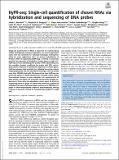HyPR-seq: Single-cell quantification of chosen RNAs via hybridization and sequencing of DNA probes
Author(s)
Marshall, Jamie L; Doughty, Benjamin R; Subramanian, Vidya; Guckelberger, Philine; Wang, Qingbo; Chen, Linlin M; Rodriques, Samuel G; Zhang, Kaite; Fulco, Charles P; Nasser, Joseph; Grinkevich, Elizabeth J; Noel, Teia; Mangiameli, Sarah; Bergman, Drew T; Greka, Anna; Lander, Eric S; Chen, Fei; Engreitz, Jesse M; ... Show more Show less
DownloadPublished version (1.275Mb)
Publisher Policy
Publisher Policy
Article is made available in accordance with the publisher's policy and may be subject to US copyright law. Please refer to the publisher's site for terms of use.
Terms of use
Metadata
Show full item recordAbstract
© 2020 National Academy of Sciences. All rights reserved. Single-cell quantification of RNAs is important for understanding cellular heterogeneity and gene regulation, yet current approaches suffer from low sensitivity for individual transcripts, limiting their utility for many applications. Here we present Hybridization of Probes to RNA for sequencing (HyPR-seq), a method to sensitively quantify the expression of hundreds of chosen genes in single cells. HyPR-seq involves hybridizing DNA probes to RNA, distributing cells into nanoliter droplets, amplifying the probes with PCR, and sequencing the amplicons to quantify the expression of chosen genes. HyPR-seq achieves high sensitivity for individual transcripts, detects nonpolyadenylated and low-abundance transcripts, and can profile more than 100,000 single cells. We demonstrate how HyPR-seq can profile the effects of CRISPR perturbations in pooled screens, detect time-resolved changes in gene expression via measurements of gene introns, and detect rare transcripts and quantify cell-type frequencies in tissue using low-abundance marker genes. By directing sequencing power to genes of interest and sensitively quantifying individual transcripts, HyPR-seq reduces costs by up to 100-fold compared to whole-transcriptome single-cell RNA-sequencing, making HyPR-seq a powerful method for targeted RNA profiling in single cells.
Date issued
2020Department
Massachusetts Institute of Technology. Department of Physics; Massachusetts Institute of Technology. Department of Biology; Massachusetts Institute of Technology. Media LaboratoryJournal
Proceedings of the National Academy of Sciences of the United States of America
Publisher
Proceedings of the National Academy of Sciences